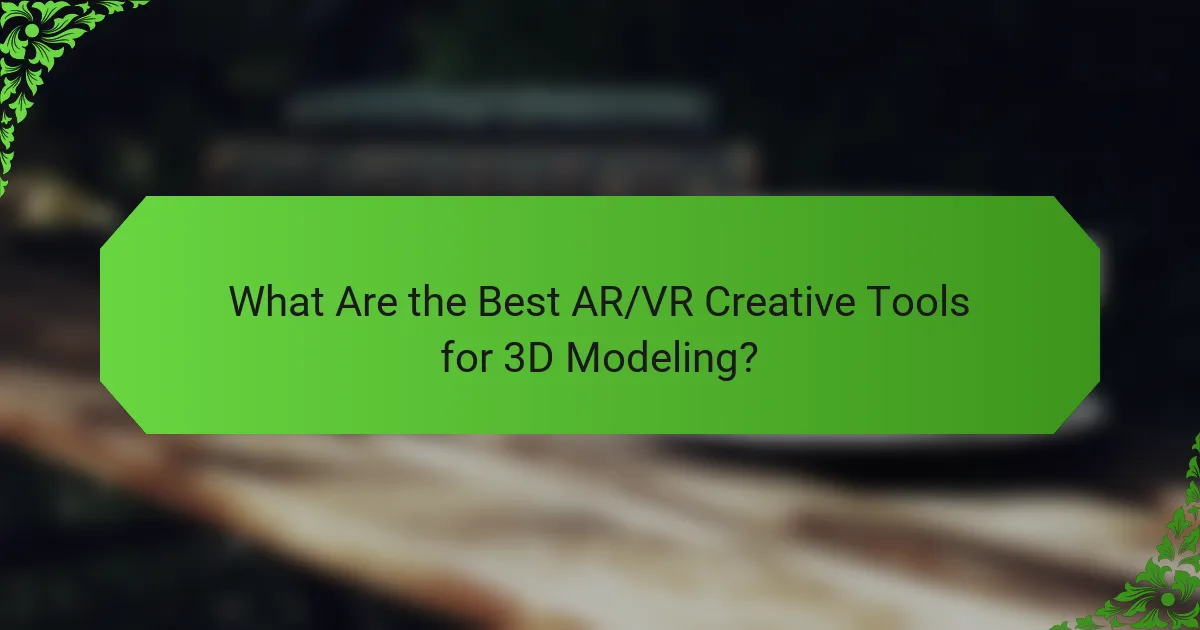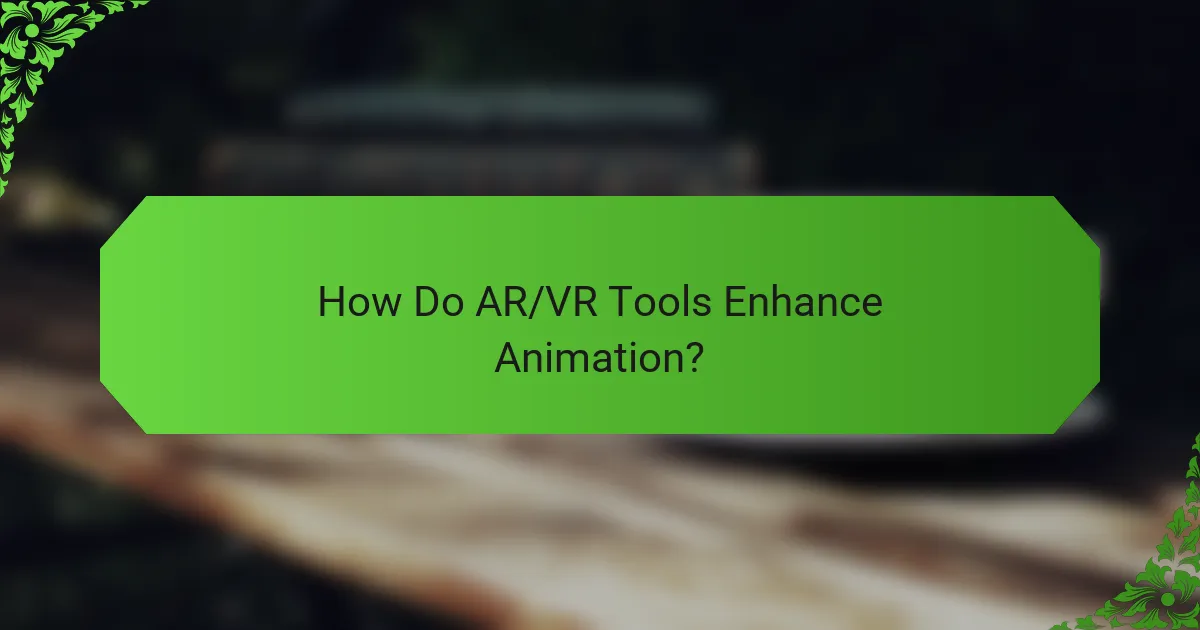In the rapidly evolving world of AR and VR, the best creative tools for 3D modeling, animation, and rendering empower artists to bring their visions to life. These software solutions cater to a range of skill levels, offering features that enhance interactivity and realism in immersive environments. By leveraging advanced rendering capabilities, creators can produce stunning visuals that elevate user experiences and storytelling in virtual spaces.

What Are the Best AR/VR Creative Tools for 3D Modeling?
The best AR/VR creative tools for 3D modeling include software that allows artists to create, animate, and render three-dimensional objects effectively. These tools vary in complexity and features, catering to different skill levels and project requirements.
Blender
Blender is a powerful open-source 3D modeling tool that supports a wide range of functionalities, including modeling, animation, and rendering. Its extensive community and vast library of plugins make it suitable for both beginners and experienced users.
One of Blender’s strengths is its flexibility; it can be used for everything from simple models to complex animations. However, the learning curve can be steep for new users, so taking advantage of tutorials and community forums is recommended.
Autodesk Maya
Autodesk Maya is a professional-grade 3D modeling and animation software widely used in the film and gaming industries. It offers advanced features like character rigging and simulation, making it ideal for high-quality production work.
While Maya is powerful, it comes with a higher price point and may require a subscription. Users should consider their specific needs and budget before committing, as there are often educational discounts available for students and educators.
Cinema 4D
Cinema 4D is known for its user-friendly interface and robust motion graphics capabilities. It is particularly favored by designers for creating stunning visual effects and animations quickly.
This software excels in integration with other Adobe products, making it a popular choice for those already working within the Adobe ecosystem. However, users should be aware that while it is easier to learn, it may lack some advanced features found in more complex tools like Maya.
3ds Max
3ds Max is another Autodesk product that is particularly strong in architectural visualization and game design. Its modeling tools are intuitive, allowing for quick creation of detailed environments and assets.
While it is powerful, 3ds Max is primarily available for Windows, which may limit accessibility for some users. Additionally, it is subscription-based, so users should evaluate their long-term project needs against the cost.
SketchUp
SketchUp is a user-friendly 3D modeling tool that is particularly popular among architects and designers for its simplicity and ease of use. It allows users to create detailed models quickly, making it ideal for concept design.
While SketchUp offers a free version, the Pro version includes additional features like advanced export options and access to a larger library of models. Users should consider their specific project requirements when choosing between the free and paid versions.

How Do AR/VR Tools Enhance Animation?
AR/VR tools significantly enhance animation by providing immersive environments that allow for interactive storytelling and realistic simulations. These tools enable creators to visualize and manipulate 3D models in real-time, offering a more engaging experience for users.
Unity
Unity is a leading platform for developing AR and VR applications, known for its user-friendly interface and extensive asset store. It supports a wide range of devices, making it versatile for both mobile and desktop applications.
When using Unity, animators can leverage its powerful physics engine and real-time rendering capabilities to create lifelike animations. The integration of AR/VR features allows for interactive elements that can respond to user input, enhancing the overall experience.
To get started, familiarize yourself with Unity’s animation tools, such as the Animator and Timeline. Avoid overcomplicating your scenes, as simpler models often perform better in AR/VR environments.
Unreal Engine
Unreal Engine is renowned for its high-fidelity graphics and robust capabilities in AR and VR development. It offers advanced rendering techniques, which are particularly beneficial for creating visually stunning animations.
With Unreal Engine, animators can utilize Blueprints, a visual scripting system, to create complex animations without extensive coding knowledge. This feature allows for rapid prototyping and iteration, making it easier to refine animations based on user feedback.
Consider using the built-in VR template to streamline your workflow. Keep in mind that while Unreal Engine provides high-quality visuals, it may require more powerful hardware compared to other tools.
Adobe After Effects
Adobe After Effects is a powerful tool for creating motion graphics and visual effects, often used in conjunction with AR and VR projects. It excels at compositing and adding intricate animations to 2D and 3D elements.
In After Effects, you can create animations that can be exported for use in AR/VR environments. The integration with Adobe’s Creative Cloud allows for seamless collaboration and asset sharing between different Adobe applications.
To maximize your workflow, utilize pre-compositions for complex animations and explore the use of plugins like Element 3D for enhanced 3D capabilities. Be cautious of rendering times, as high-resolution projects can significantly increase processing demands.

What Are the Top Rendering Tools for AR/VR?
The top rendering tools for AR/VR include advanced software that enables creators to produce high-quality visuals and immersive experiences. These tools are essential for artists and developers looking to enhance their projects with realistic lighting, textures, and animations.
V-Ray
V-Ray is a powerful rendering engine widely used in the AR/VR industry for its ability to create photorealistic images. It integrates seamlessly with popular 3D modeling software like SketchUp and 3ds Max, making it a versatile choice for designers.
Key features include advanced global illumination, realistic materials, and a robust set of rendering options. Users should consider the learning curve, as mastering V-Ray can take time, but the results are often worth the effort.
Octane Render
Octane Render is known for its speed and efficiency, utilizing GPU rendering to produce high-quality images quickly. This tool is particularly favored for real-time rendering, which is crucial for AR/VR applications where performance is key.
With a user-friendly interface and support for a wide range of 3D applications, Octane allows artists to experiment with lighting and materials easily. However, users should ensure their hardware meets the necessary specifications to fully leverage Octane’s capabilities.
KeyShot
KeyShot is a rendering tool that excels in creating stunning visuals with minimal setup time. It is particularly popular among product designers and marketers for its intuitive workflow and real-time rendering capabilities.
KeyShot supports a variety of file formats and offers extensive libraries of materials and environments. While it is less suited for complex animations compared to other tools, its ease of use makes it an excellent choice for quick visualizations and presentations.

What Criteria Should You Consider When Choosing AR/VR Tools?
When selecting AR/VR tools, consider compatibility with platforms, user interface and experience, as well as community support and resources. These factors significantly influence the effectiveness and ease of use of the tools in your creative projects.
Compatibility with platforms
Compatibility with various platforms is crucial when choosing AR/VR tools. Ensure that the software you select works seamlessly with the devices and operating systems you plan to use, such as Oculus, HTC Vive, or mobile devices like iOS and Android. This can affect the performance and accessibility of your projects.
Check for support of popular file formats and integration capabilities with other software. Tools that are compatible with multiple platforms can save time and resources, allowing for a more versatile workflow.
User interface and experience
The user interface and overall experience of AR/VR tools can greatly impact your productivity. Look for tools that offer intuitive navigation, clear menus, and customizable settings to enhance your workflow. A well-designed interface can reduce the learning curve, making it easier to create and iterate on your projects.
Consider trying out demos or free trials to assess how comfortable you feel using the software. A positive user experience can lead to more efficient project development and better creative outcomes.
Community support and resources
Strong community support and available resources are essential for troubleshooting and learning. Tools with active user communities often provide forums, tutorials, and documentation that can help you overcome challenges and improve your skills. Look for platforms that offer extensive online resources, such as video tutorials or user-generated content.
Engaging with a community can also provide networking opportunities and insights into best practices. Choose tools that have a vibrant ecosystem to ensure you have access to ongoing support and inspiration throughout your creative journey.

What Are the Pricing Models for AR/VR Creative Tools?
The pricing models for AR/VR creative tools vary significantly, catering to different user needs and budgets. Common models include subscription-based pricing, one-time purchases, and options for free trials or freemium access, each with its own advantages and considerations.
Subscription-based pricing
Subscription-based pricing involves paying a recurring fee, typically monthly or annually, to access AR/VR creative tools. This model often includes regular updates and customer support, making it appealing for users who want the latest features without a large upfront investment.
Prices for subscriptions can range from around $10 to $100 per month, depending on the tool’s capabilities and the level of service offered. This model is ideal for freelancers and small studios that require flexibility and scalability in their software usage.
One-time purchase
A one-time purchase model requires users to pay a single fee to own the software outright. This can be advantageous for those who prefer not to commit to ongoing payments. However, users may miss out on future updates or support unless they pay for upgrades.
Prices for one-time purchases can vary widely, often falling between $100 and $1,500, depending on the complexity and functionality of the tool. This option is suitable for established professionals or companies that need specific features without ongoing costs.
Free trials and freemium options
Free trials and freemium options allow users to test AR/VR creative tools at no cost before committing to a purchase. Free trials typically last for a limited time, while freemium models offer basic features for free, with the option to upgrade for advanced functionalities.
These options are beneficial for beginners or those exploring new tools, as they provide a risk-free way to evaluate software. However, users should be aware of potential limitations in features or usage time, which can affect their overall experience and learning curve.